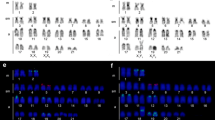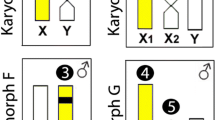Abstract
The karyotype and other chromosomal markers as revealed by C-banding and Ag-staining were studied in Lutjanus quinquelineatus and L. kasmira (Lutjanidae, Perciformes). While in latter species, the karyotype was invariably composed of 48 acrocentric chromosomes in both sexes, in L. quinquelineatus the female karyotype had exclusively 48 acrocentric chromosomes (2n = 48) but that of the male consisted of one large metacentric and 46 acrocentric chromosomes (2n = 47). The chromosomes in the first meiotic division in males showed 22 bivalents and one trivalent, which was formed by an end-to-end association and a chiasmatic association. Multiple sex chromosome system of X1X1X2X2/X1X2Y type resulting from single Robertsonian fusion between the original Y chromosome and an autosome was hypothesized to produce neo-Y sex chromosome. The multiple sex chromosome system of L. quinquelineatus appears to be at the early stage of the differentiation. The positive C-banded heterochromatin was situated exclusively in centromeric regions of all chromosomes in both species. Similarly, nucleolus organizer region sites were identified in the pericentromeric region of one middle-sized pair of chromosomes in both species. The cellular DNA contents were the same (3.3 pg) between the sexes and among this species and related species.






Similar content being viewed by others
References
Almeida-Toledo LF, Daniel-Silva MF, Lopes CE, Toledo-Filho SA (2000a) Sex chromosome evolution in fish. II. Second occurrence of an X1X2Y sex chromosome system in Gymnotiformes. Chrom Res 8:335–340
Almeida-Toledo LF, Foresti F, Daniel MFZ, Toledo-Filho SA (2000b) Sex chromosome evolution in fish: the formation of the neo-Y chromosome in Eigenmannia (Gymnotiformes). Chromosoma 109:197–200
Almeida-Toledo LF, Foresti F, Toledo-Filho SA (1984) Complex sex chromosome system in Eigenmannia sp. (Gymnotiformes). Genetica 64:165–169
Bertollo LAC, Takahashi CS, Moreira Filho O (1983) Multiple sex chromosomes in the genus Hoplias (Pisces: Erythrinidae). Cytologia 48:1–12
Bertollo LAC, Fontes MS, Fenocchio AS, Cano J (1997) The X1X2Y sex chromosome system in the fish Hoplias malabaricus. I. G-, C- and chromosome replication banding. Chrom Res 5:493–499
Bertollo LAC, Mestriner CA (1998) The X1X2Y sex chromosome system in the fish Hoplias malabaricus. II. Mitotic analyses. Chrom Res 6:141–147
Caputo V, Machella N, Nisi-Cerioni P, Olmo E (2001) Cytogenetics of nine species of Mediterranean blennies and additional evidence for an unusual multiple sex-chromosome system in Parablennius tentacularis (Perciformes, Blenniidae). Chrom Res 9:3–12
Choudhury RC, Prasad R, Das CC (1979) Chromosomes of six species of marine fishes. Caryologia 32:15–21
Howell WM, Black DA (1980) Controlled silver-staining of nucleolus organizer regions with a protective colloidal developer: a 1-step method. Experientia 36:1014–1015
Masuda AH, Amaoka K, Araga C, Uyeno T, Yoshino T (eds) (1984) The fishes of the Japanese archipelago. Tokai University Press, Tokyo
Morescalchi A, Hureau JC, Olmo E, Ozouf-Costaz C, Pisano E, Stanyon R (1992) A multiple sex-chromosome system in Antarctic ice-fishes. Polar Biol 11:655–661
Murofushi M, Oikawa S, Nishikawa S, Yosida TH (1980) Cytogenetical studies on fishes. 3. Multiple sex chromosome mechanism in the filefish, Stephanolepis cirrhifer. Jpn J Genet 55:127–132
Murofushi M, Nishikawa S, Yoshida TH (1983) Cytogenetical studies on fishes. δ. Multiple sex chromosome mechanism (XX-Y) found in two Dragonet fishes. Proc Jpn Acad 59B:58–61
Murofushi M, Yosida TH (1984) Cytogenetical studies on fishes. 8. XX-Y Sex chromosome mechanism newly found in the snake eel, Muraenichthys gymnotus. Proc Jpn Acad 60B:21–23
Nelson JS (2006) Fishes of the world, 4th edn. Wiley, New Jersey
Ohno S (1967) Sex chromosomes and sex-linked genes. In: Labhart A, Mann T, Samuels LT (eds) Monographs on endocrinology 1. Springer, Heidelberg
Ohno S (1974) Protochordata, cyclostomata, and pisces. In: Animal cytogenetics, vol. 4. Chordata 1. Borntraeger, Berlin, pp1–92
Ojima Y (1983) Fish cytogenetics. In: Sharma AK, Sharma A (eds) Chromosomes in evolution of eukaryotic groups 1. CRC, Florida, pp 111–145
Ojima Y, Kikuno T (1986) A heteromorphic chromosome of Beryx splendens, Berycidae (Pisces). Proc Jpn Acad 62B:317–320
Okamura O, Amaoka K (eds) (2004) Marine fishes of Japan, 3rd edn. Yama-to-Keikoku Sya
Patro R, Prasad R (1979) Chromosomes of six marine percoids from the Indian sea. Ind Biologist 11:9–12
Pezold F (1984) Evidence for multiple sex chromosomes in the freshwater goby, Gobionellus shuffldti (Pisces: Gobiidae). Copeia 1984:235–238
Rishi KK (1973) A preliminary report on the karyotypes of eighteen marine fishes. Res Bull Panjab Univ 24:161–162
Saitoh K (1989) Multiple sex-chromosome system in a loach fish. Cytogenet Cell Genet 52:62–64
Schmidtke J, Zenzes MT, Weiler C, Bross K, Engel W (1976) Gene action in fish of tetraploid origin. V. Ribosomal DNA amount in clupeoid and salmonid fish. Biochem Genet 14:975–980
Singh L, Purdom IF, Jones KW (1976) Satellite DNA and evolution of sex chromosomes. Chromosoma 59:43–62
Sumner AT (1972) A simple technique for demonstrating centromeric heterochromatin. Exp Cell Res 75:304–306
Suzuki A, Taki Y, Takeda M, Akatsu S (1988) Multiple sex chromosomes in a monodactylid fish. Jpn J Ichthyol 35:98–101
Takai A, Ojima Y (1986) Some features on nucleolus organizer regions in fish chromosomes. In: Indo-Pacific Fish Biology, Ichthyological Society of Japan, Tokyo, pp 899-909
Takai A, Ojima Y (1999) Constitutive heterochromatin distribution in the chromosomes of pomacentrid fishes. Cytologia 64:87–91
Ueda T, Ojima Y (1984) Sex chromosomes in the kokanee salmon Oncorhynchus nerka. Bull Jpn Soc Sci Fish 50:1495–1498
Ueno K, Kang J-H (1992) Multiple sex chromosomes in the redfin velevetfish, Hypodytytes rubripinnis. Jpn J Ichthyol 39:170–173
Ueno K, Ojima Y (1992) Notes on the chromosomes of Girella melanichthys and Lutjanus russelli (Pisces, Perciformes). CIS 52:3–5
Uyeno T, Miller RR (1971) Multiple sex chromosomes in a Mexican cyprinodontid fish. Nature 231:452–453
Uyeno T, Miller RR (1972) Second discovery of multiple sex chromosomes among fishes. Experientia 28:223–225
Author information
Authors and Affiliations
Corresponding author
Rights and permissions
About this article
Cite this article
Ueno, K., Takai, A. Multiple sex chromosome system of X1X1X2X2/X1X2Y type in lutjanid fish, Lutjanus quinquelineatus (Perciformes). Genetica 132, 35–41 (2008). https://doi.org/10.1007/s10709-007-9146-5
Received:
Accepted:
Published:
Issue Date:
DOI: https://doi.org/10.1007/s10709-007-9146-5




